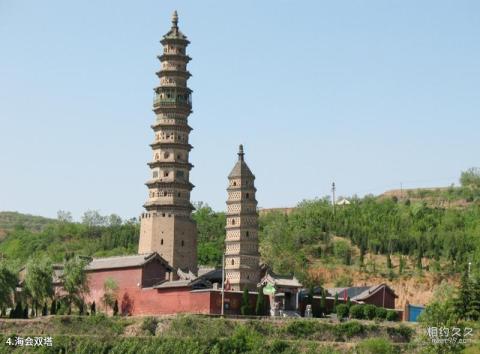
Introduction to Haihui Twin Towers: Haihui Temple Pagoda Yard, with two entrances to the courtyard. In the courtyard stands the landmark building of Haihui Temple - Haihui, praised as "a national treasure" by experts from the China Architectural Design Institute. twin towers. This plump and simple brick pagoda was built in the late Tang Dynasty and early Liang Dynasty, more than a thousand years ago. The tower is hexagonal and ten-level, more than 20 meters high. The interior of the tower is spacious, with door openings at the intersection. The murals are full of three regular rows of small statues, with exquisite craftsmanship and simple shapes. The outer brick walls of the pagoda are densely covered with Buddhist niches, and the niches are filled with seated Buddhas, so it is also called the "Thousand Buddha Pagoda". This pagoda was originally a "relic pagoda" built for Zen Master Shunmin by his disciples after his death. This slim and exquisite glazed pagoda was built during the Jiajing and Longqing years of the Ming Dynasty, imitating the Liuhe Pagoda on Yuelun Mountain in the south of West Lake. This tower has 13 octagonal floors and is more than 50 meters high. Each floor of the tower is equipped with an inner chamber. Outside the inner chamber, there is a spiral passage in the thick tower wall. There are brick steps in the passage, which spiral. It can reach directly to the top of the tower. It has an octagonal appearance and decreases upwards layer by layer. The three-layer brackets, double eaves and the tower body are very moderate in scale and projection design. There are also iron bells at the eaves corners of each floor. Whenever the breeze blows, you can hear the sweet sound. These are the features of the Six Harmonies Pagoda in West Lake. However, this pagoda is both an imitation and an innovation. This pagoda is more exquisite and beautiful than the Liuhe Pagoda. The builder added many glazed components to the pagoda body, making the glazed pagoda even more radiant. In particular, a circle of flat seats extends outward on the tenth floor of the tower and is surrounded by glazed railings, forming a magnificent suspended pavilion. Professor Zhang Yuhuan, an expert on ancient Chinese pagodas, wrote in China Cultural Relics News: "This is the only good example among the pavilion-style pagodas in the north."
